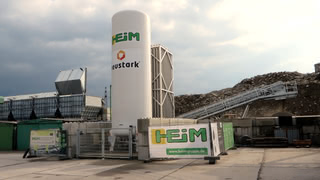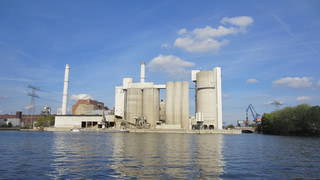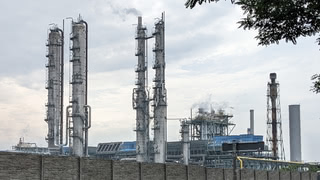You want CCS, but cheaper and less controversial? Try Biomethane
Carbon capture technology is often associated with ideas of capturing CO₂ from power plants or industrial facilities like cement plants. Biomethane upgraders provide CO₂ that is easy to capture and less controversial than most other potential sources for CCS and also CCU. Yet, they are rarely part of the discussion.

When it comes to climate solutions, Carbon Capture and Storage, or short CCS, is certainly one of the more controversial approaches. Capturing and geologically storing CO₂ from emission sources rather than avoiding it in the first place is seen by many as a distraction by the fossil fuel industry to delay meaningful climate action. Yet, others see it as a crucial tool to tackle climate change.
Starting around the year 2007, CCS was widely discussed as an option to allow continued use of fossil fuels in power plants. However, neither "Clean Coal" in the United States nor "Norway's moon landing", as former prime minister Jens Stoltenberg called CCS at the gas power plant Mongstad, were ever implemented on any meaningful scale.
Today, the debate has shifted. Industries like cement, which have few or no other options, are seen as primary use cases for CCS. The production of cement causes carbon dioxide emissions that are a byproduct of the chemical process. Even electrified cement plants would have these emissions.
Yet, it is important to recognize that most existing CCS projects have little to do with either of these ideas. They neither capture CO₂ from power plants nor from hard-to-abate industrial processes. By far the most common carbon dioxide sources for existing CCS projects are fossil gas upgrading facilities. Furthermore, most existing CCS projects are truly Enhanced Oil Recovery (EOR) projects. The CO₂ is pumped into aging oil fields to increase extraction.
Most existing CCS projects use CO₂ from Fossil Gas Processing
Raw fossil gas typically comes mixed with other gases, most notably CO₂. To prepare fossil gas for the grid, CO₂ and other unwanted gases must be removed. This gas upgrading process, which separates Methane and other energy-rich gases from unwanted CO₂, is the main source for CCS today. The reason is that it is relatively simple and cheap. Separation from the gas has to happen anyway. Highly concentrated CO₂ is, therefore, already available.
Capturing carbon dioxide from a power plant, also known as post-combustion carbon capture, is quite different. The flue gas from a power plant or other combustion processes is primarily composed of Nitrogen. CO₂ concentration is usually less than 10 percent and sometimes much lower. Notably, gas power plants have a particularly low concentration of CO₂ in their flue gas.
This separation of CO₂ is commonly done with a technology named Amine scrubbing. Due to the high costs and energy needs, post-combustion CCS with Amine scrubbing has never been widely implemented. (It should be noted that Amine scrubbing is also often the technology used in gas upgraders to separate CO₂ from Methane.)
Can BECCS cool down the planet?
CCS on a fossil fuel emission source can, at best, lead to a CO₂-neutral scenario where no additional carbon dioxide is added to the atmosphere. In practice, even that is not possible, as CO₂ capture rates never reach 100 percent.
However, if we consider bioenergy, things can be different. Plants use photosynthesis to extract CO₂ from the air. Therefore, if CCS is coupled with the use of bioenergy, it can remove carbon from the atmosphere. (There are many caveats with this. Most notably, growing bioenergy crops can itself be a major source of emissions.)
Carbon Brief has an insightful article about the history of BECCS and its role in the climate science community.
BECCS could operate on power plants using biogenic fuels like wood or straw. Unsurprisingly, such a form of post-combustion BECCS faces similar challenges as CCS for fossil fuel power plants. Notably, the CO₂ concentration in the flue gas is low, and separating it is costly and requires plenty of energy.
Currently, there are no operational BECCS power plants. Two plants operated by Ørsted in Denmark will likely start to capture and store CO₂ soon.
On top of the challenges with post-combustion BECCS, using bioenergy for power generation is also controversial, even when it utilizes residual biomass. It can be the source of air pollution, and sustainable biomass should likely be prioritized for use cases with few alternatives.
Making Biogas and Biomethane through Anaerobic Digestion
Biogas is an energy source that can be made from various biogenic inputs like food waste, manure, or energy crops like corn. The process is called Anaerobic Digestion. It describes the decomposition of wet biomass in the absence of Oxygen.
Biogas is a mixture of around 60 percent Methane, 40 percent CO₂, and residual other gases. It also produces a biogenic digestate as a by-product, which can be used as a fertilizer. Biogas can be directly used as an energy source. However, it can also be upgraded to a more valuable product by removing CO₂. This upgraded Biogas is commonly called Biomethane or Renewable Natural Gas (RNG).
As Methane is also the main component of fossil gas, Biomethane can be injected into existing gas grids and is essentially a drop-in replacement for fossil gas.
(There is also a process called gasification that can convert biomass into syngas. It is important to clarify that Anerobic Digestion and gasification are two entirely different technologies. Gasification is not the topic of this text.)
In principle, using Anaerobic Digestion to turn biogenic waste into Biogas and Biomethane should not be particularly controversial, but there are controversies surrounding the production methods and uses of Biomethane.
Biogas made from energy crops like corn requires agricultural land and, if the full lifecycle is taken into account, has a high emission footprint. Corn-Biogas is particularly common in Germany. In neighboring Denmark, using corn for Biogas is banned, and other energy crops are restricted to small shares.
Even Biogas from biogenic waste is not without controversy, as a common source is manure from animal agriculture, which is itself a major source of greenhouse gas emissions.
Methane is a potent greenhouse gas, which is why leaks need to be considered and should be minimized. Methane leakage from Biogas is sometimes mitigated by the fact that many of its potential inputs, notably manure, would cause more emissions of both Methane and Nitrous Oxide if they are not fed into an Anaerobic Digestion plant.
There is a whole separate discussion about landfill gas, which is also the result of Anaerobic Digestion. In a sense, poorly managed landfills are uncontrolled Anaerobic Digestion plants. Capturing this gas can reduce emissions, but it would be better not to have poorly managed landfills in the first place.
Why Biomethane with CCS?
Let's quickly reiterate. Anaerobic Digestion produces a mixture of Methane and CO₂, which we call Biogas. By removing CO₂, Biogas can be upgraded to Biomethane and used as a drop-in replacement for fossil gas. It can be transported and stored with existing gas infrastructure.
Biomethane upgraders generate CO₂ in high concentrations as a by-product. As we learned earlier, most existing CCS projects use CO₂ from fossil gas upgraders because their concentrated CO₂ is a cheaper option than other emission sources. Likewise, Biomethane upgraders are a relatively cheap option to source biogenic CO₂.
To put it another way: Biomethane upgraders are the equivalent in the renewable energy world to the most common source of CO₂ in fossil fuel CCS projects.
While Biomethane upgrade facilities are a good source of concentrated CO₂, today, it is often vented into the atmosphere. This is quite unfortunate and stems from the outdated view that biogenic CO₂ emissions don't count. Emitting concentrated biogenic CO₂ sources has an opportunity cost that needs to be taken into account.
If we take CO₂ from Biomethane upgraders and put it into geological storage, that is a form of BECCS (Bio Energy with Carbon Capture and Storage). However, it is quite different from the type of BECCS that captures CO₂ from the combustion of biogenic energy sources. Instead of capturing emissions from bioenergy use, it captures emissions from the processes used to provide bioenergy. It has a major advantage, as it bypasses expensive CO₂ extraction from flue gas.
I talked to Raphael Pfaeltzer, who works for The Carbon Removers, a company from Scotland implementing CO₂ capture projects on Biomethane upgraders and other biogenic processes. "Some of my colleagues and I used to work with more traditional BECCS and Direct Air Capture for a few years," says Pfaeltzer. "However, we realised that their energy use is difficult to justify when there is so much high-purity biogenic CO₂ from Biomethane plants or similar fermenters."
There is a similar source of biogenic CO₂ process emissions worth mentioning. The production of Bioethanol also provides a concentrated CO₂ source. One of the largest existing BECCS projects is utilizing CO₂ from an Ethanol production plant in Illinois. It is operated by the company ADM and has lately faced some challenges due to corroding steel.
However, Bioethanol production is often based on energy crops. Attempts to scale second-generation Bioethanol production from residuals have, so far, not been very successful. Biomethane is different, as the use of residuals and waste is already very common.
Biomethane with CCS bypasses two major challenges
By utilizing CO₂ from Biomethane upgraders, CCS projects circumvent two major challenges. It is less controversial, as it is not tied to fossil fuel production and use. Furthermore, it does not need a costly CO₂ separation step from a combustion flue gas.
While Biomethane upgraders are not exactly at the core of the CCS debate, there are some projects in that space. In 2023, I interviewed Marco Mazzotti about a research project at ETH Zürich testing CO₂ transport from a Biomethane plant in Switzerland to a storage site in Iceland.
Today, Marco Mazzotti works for the carbon removal company Neustark, which was co-founded by one of his students. Neustark stores CO₂ from Biomethane plants in demolished concrete and sells carbon removal certificates.
In Denmark, the government ran a tender for negative emission CCS (NECCS). In 2024, the Danish Energy Agency (Energistyrelsen) selected three companies that will receive funding. All three are using CO₂ from Biomethane upgraders. The smallest one is operated by the previously mentioned company The Carbon Removers (previously Carbon Capture Scotland). The two larger ones will be operated by the Biomethane producers BioCirc and Bioman. The latter was recently acquired by Bigadan, another Biomethane producer.
If everything goes as planned, the three projects will remove around 160,000 tons annually starting in 2026 and store them in the Greensand storage site. Worth noting is, however, that the Danish government had originally expected to support much larger volumes of up to 500,000 tons annually via the NECCS tender.
According to a recent report by the European Biogas Association, existing Biomethane upgrading in Europe currently generates around 5.4 million tons of biogenic CO₂. The report further states: "If all biogas produced in 2023 had been upgraded, the biogas industry would have separated a total of 29 million tons of biogenic CO₂."
The report sees a potential of up to 120 million tons of CO₂ from anaerobic digestion by 2050 within the EU. That, of course, assumes a substantial expansion of Biogas and Biomethane capacity. (For comparison, EU emissions in 2024 had been around 3,300 million tons of CO₂.)
Biomethane production relies on available biomass, and sustainable biomass is a limited resource. But the potential for Biomethane with CCS appears large enough to be significant.
While it is cheaper than many other forms of CCS, permanently storing CO₂ from Biomethane upgraders is obviously not free. In the European Union, CO₂ emissions are priced through the Emission Trading System (ETS). However, that does not help to support Biomethane with CCS, as biogenic emissions are included in the ETS.
There are only a few sources of funding. Apart from government programs, such as the Danish NECCS tender, these projects often rely on voluntary carbon removal credits.
One of the largest buyers of carbon removal credits is Frontier, an organization with backing from IT corporations like Stripe and Google. However, Frontier currently excludes Biomethane upgrading from its portfolio.
Frontier mentions some valid concerns like Methane leakage. However, that could be addressed by requiring close monitoring and minimization of Methane emissions and is mitigated if Biogas plants use inputs that would otherwise cause even more Methane.
Frontier also points out that digestate created by Anaerobic Digestion can cause CO₂ emissions when decomposing, leading to a low CDR efficiency. It appears that by "CDR efficiency", Frontier refers to the amount of carbon stored compared to the amount of carbon contained in input materials. With this reasoning, any process that produces a biogenic product and creates CO₂ in the process would have a low CDR efficiency.
Frontier's reasons for excluding Biomethane do not appear to be particularly convincing, especially considering that Frontier allows far more problematic CO₂ sources like waste-to-energy plants. I asked Frontier for a statement, but I have not received a reply.
CO₂ for the food Industry and E-Methanol production
Apart from permanently storing biogenic CO₂, it can also be used in other industries. Some Biomethane upgraders sell CO₂ to the food industry. Even though this CO₂ is later released into the atmosphere, it can still have climate benefits, as food industry CO₂ is sometimes mined from geological sources.
Another use case is the production of e-fuels and e-chemicals from CO₂ and Hydrogen. As previously discussed here, those technologies known as Carbon Capture and Utilization (CCU) should not rely on fossil CO₂ sources. With direct air capture being prohibitively expensive, that leaves biogenic CO₂ sources as the primary option.
The only large-scale E-Methanol plant currently operational in Europe is located in the Danish municipality of Kassø, operated by European Energy. It uses CO₂ from the nearby Tønder Biogas plant, one of the largest Biomethane upgraders in Europe.
A CO₂ source is also needed for the production of Urea fertilizers from green Ammonia. Urea production requires CO₂ that is usually sourced from the adjacent fossil Hydrogen production. When that goes away, CCS from Biomethane could provide an alternative.
Biomethane Upgraders are much smaller than Fossil Gas Upgraders
While CCS in combination with Biomethane upgraders has many attractive properties, there are some challenges.
"Biomethane is an ideal case for CCS," says Tobias Johan Sørensen from the Danish climate think tank CONCITO, who has closely followed the development in Denmark. "However, the market for transport and storage is still immature, which challenges the scale-up of CCS. Furthermore, Biomethane producers are relatively small emitters spread across the country."
The mentioned Tønder Biogas plant, one of the largest Biomethane upgraders in Europe, produces around 50,000 tons of CO₂. Many Biomethane plants produce less than 10,000 tons of CO₂. Fossil gas upgraders usually produce much larger CO₂ volumes.
The Sleipner gas upgrader in Norway, equipped with CCS in 1996 and one of the oldest CCS projects, produced up to a million tons of CO₂ annually. (It captured much less in recent years due to declining gas production in the Sleipner field. Sleipner also had occasional technical problems and overreported CO₂ volumes stored due to faulty measuring equipment between 2017 and 2021.)
The smaller size of Biomethane upgraders has implications for the infrastructure. Connecting Biomethane upgraders to pipeline networks is more challenging compared to larger emission sources. Existing projects usually rely on less efficient CO₂ transport by truck in containers. That obviously comes with its own CO₂ emissions as long as transport is not fully decarbonized.
Those emissions, however, do not negate the carbon removal effects. When I raised this issue interviewing Neustark's Valentin Gutknecht last year, he pointed me to a Life Cycle Assessment that estimates a carbon efficiency of 93 percent for Neustark's operations in Switzerland with CO₂ transport by truck. In this scenario, for each ton of CO₂ stored, around 70 kg of CO₂ are emitted.
The infrastructure challenges also raise questions about the planning of future Biogas and Biomethane plants. If one wants to optimize them for CCS or CO₂ use, it might make sense to focus on larger plants. Another possibility is to collect Biogas from multiple plants using a small Biogas grid and deliver it to a larger Biomethane upgrader.
Biomethane with CCS is often not even part of the discussion
Even with infrastructure challenges and other caveats in mind, Biomethane upgrading with CCS appears like an attractive option. Yet, that is hardly reflected in the wider debate.
In 2023, the environmental NGOs Bellona Germany and E3G published a CCS Ladder (inspired by the famous Hydrogen ladder), rating different applications of CCS. In 2024, the Kleinman Center for Energy Policy at the University of Pennsylvania published a similar CCS Ladder. What both have in common is that Biomethane upgraders are not even mentioned. Notably, neither are fossil gas upgraders, even though they are the most common type of existing CCS projects.
The Global CCS Institute publishes an annual report about CCS. It is an important and widely recognized document within the CCS industry. Its latest 2024 edition does not even mention the words Biomethane or Biogas. (It does contain a brief mention of the Danish NECCS tender, but without any details.)
It appears Biomethane with CCS is currently largely unknown. Yet, if we look at the projects in Denmark, it could soon become one of the most significant carbon removal options available.
Most readers will be familiar with Climeworks, the world's leading direct air capture company. Its two plants in Iceland have a combined capacity of around 40,000 tons, but real-world performance is much lower.
If things go as planned, the Biomethane producers Bigadan and BioCirc will soon run some of the largest carbon removal projects in the world; Climeworks pales in comparison. Yet, most of you have probably never heard the names BioCirc and Bigadan.
Author: Hanno Böck
Brief
-
The NGO Ember has published a report about the impact of Methane emissions from coal mining for the steel industry.
-
Heidelberg Materials has announced a final investment decision for a CCS facility at its Padeswood cement plant in the UK.
-
Tata Steel in the Netherlands has signed a non-binding Letter of Intent with the government of the Netherlands and the local province for the transformation of its steel site in IJmuiden. Tata Steel wants to shut down its blast furnace and coke plant and replace them with a Direct Reduction (DRI) plant, initially operated with fossil gas. Later, the company plans to implement CCS and potentially switch to Hydrogen or Biomethane.
-
In Australia, ABC uncovered a Methane leak at the Darwin LNG plant. It was internally known for years, but neither the authorities nor the owner informed the public. ABC's investigation may have derailed a planned sale of Santos, the owner of the plant, to an investment consortium from Abu Dhabi.
-
The Global Impact Coalition has announced a collaboration to develop gasification technology in order to convert waste into chemicals. It involves various large chemical companies and researchers from ETH Zürich. Gasification has been a topic here before and could be a promising way to use various types of waste as a chemical feedstock. But making the technology work reliably is challenging. Many waste gasification projects have failed in the past.



